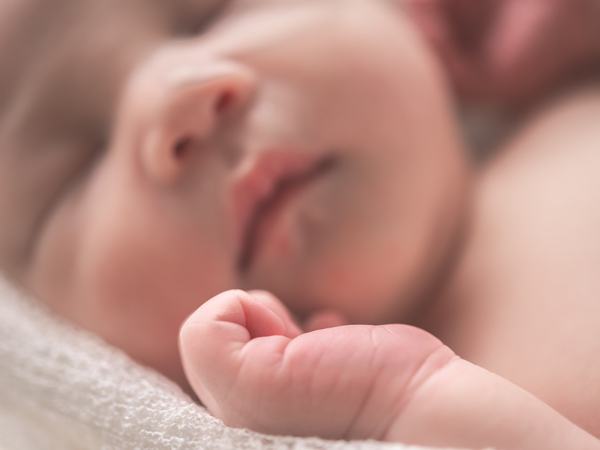How to create a safe sleeping environment for your baby
With a baby in the family, many things in your family life change in one fell swoop.
It's not just everyday life that's affected, but also the many nights you spend together as a family. In the beginning, we often don't know what to pay attention to in order to make it work safely. Therefore, with the following tips, we want to show you how to make sure that above all your baby, but also you, sleep well and safely.
1. children under 12 months should sleep in the supine position
Let's start with a very important point. Babies should sleep on their backs because it reduces the risk of sudden infant death syndrome (SIDS). SIDS is the unexplained and sudden death of an otherwise healthy baby in his or her sleep. Sleeping on your back has been shown to reduce the risk of SIDS and is recommended by medical professionals and organizations around the world.

Although the supine position is the safest sleeping position for babies, it is also important to provide them with a safe sleeping environment overall. The following tips will help you do this.
2. baby with parents in the room as well as their own bed during the first few months.
It is recommended that babies sleep in the same room as their parents for the first twelve months of life. However, for at least the first three months, the baby should sleep in his or her own crib - for example, a rollaway bed.
Both help to reduce the risk of SIDS.
Because, if the baby sleeps in close proximity to the parents, it is easier to monitor him and detect any breathing problems or emergencies. This way, you can respond more quickly if your baby has trouble during sleep.
Unfortunately, if your baby sleeps in bed with you during the first few months, this poses a safety risk. This is because it increases the risk of the baby accidentally suffocating, becoming trapped or overlapping.
However, this risk primarily applies to families where the baby does not sleep in the family bed with you on a regular basis, but as an exception. Similarly, the family bed has been defined differently in many studies. For example, sleeping on the sofa with an alcoholic babysitter was also included. For a detailed discussion of family bed safety, see the blog kinder-verstehen.de by pediatrician and author Herbert Renz-Polster.
3 A firm mattress is mandatory
A safe sleep environment also includes babies sleeping on a firm mattress instead of a soft mattress. This also reduces the risk of suffocation and SIDS.
This is because soft mattresses that conform too closely to the baby's body can increase the risk of suffocation or carbon dioxide rebreathing. A firm mattress, on the other hand, provides good air circulation around the baby's face and reduces the risk of babies sinking into the mattress or being trapped in awkward positions during sleep.
Therefore, when choosing a baby mattress, it is important to choose one that meets safety standards: it should be firm, flat, and fit snugly in the crib without leaving gaps around the edges.
4. no objects in the bed
Soft objects such as pillows, blankets or stuffed animals can pose a choking risk to babies, especially during sleep. Babies are unable to free themselves from these objects if they accidentally cover their faces. This can lead to respiratory distress or the choking hazard just mentioned.
Also, soft objects can contribute to overheating, which is again a risk factor for SIDS, as babies cannot regulate their body temperature as well as adults.
5. appropriate sleepwear
Sleeping bags offer a safe alternative to blankets in the crib, as loose blankets can be a suffocation and entanglement hazard for babies. Sleeping bags prevent baby's face from being covered by a blanket.
When choosing a sleeping bag, it is important that you choose one that is appropriate for your baby's age, size, and room temperature. In this way, sleeping bags can create a safer, comfortable and conducive sleeping environment for babies, reduce the risk of accidents and promote better sleep.
6. The right sleeping temperature for baby's sleep.
Studies have shown that room temperature also plays a role in reducing the risk of sudden infant death syndrome. A room temperature between 16°C and 20°C is recommended for safer sleep. This temperature range contributes to a comfortable sleeping environment and reduces the risk of overheating.

7. create a smoke-free environment
Indisputably, it is important for babies to sleep in a smoke-free environment for several reasons. For one, exposure to secondhand smoke is strongly associated with an increased risk of SIDS. Second, it puts respiratory health at risk: asthma, bronchitis and increased susceptibility to respiratory infections like pneumonia can result.
Creating a smoke-free environment not only protects the baby, but you as a whole family.
8. airing the bedroom regularly
Ventilation plays an important role in creating better sleeping conditions.
It ensures that there is an adequate supply of oxygen in the room. It also helps remove odors and allergens from the sleeping area. Proper ventilation also helps regulate the temperature of the room, preventing it from getting too hot or too cold.
By improving air quality, regulating temperature, reducing humidity, reducing odors and promoting oxygen circulation, you are creating a more comfortable and healthier sleep environment for you and your baby through ventilation. This, in turn, contributes to better sleep quality, peace of mind and overall well-being.
Now we have come to the end. In conclusion, we hope these tips will be of help to you in sleeping well and safely as a family. Also, feel free to check us out at Heart Parents. There you will find more informative and exciting posts about the colorful and exciting family life.
Image sources:
- Cover image: unsplash.com
- Image 1: unsplash.com
- Image 2: unsplash .com
No comments yet.